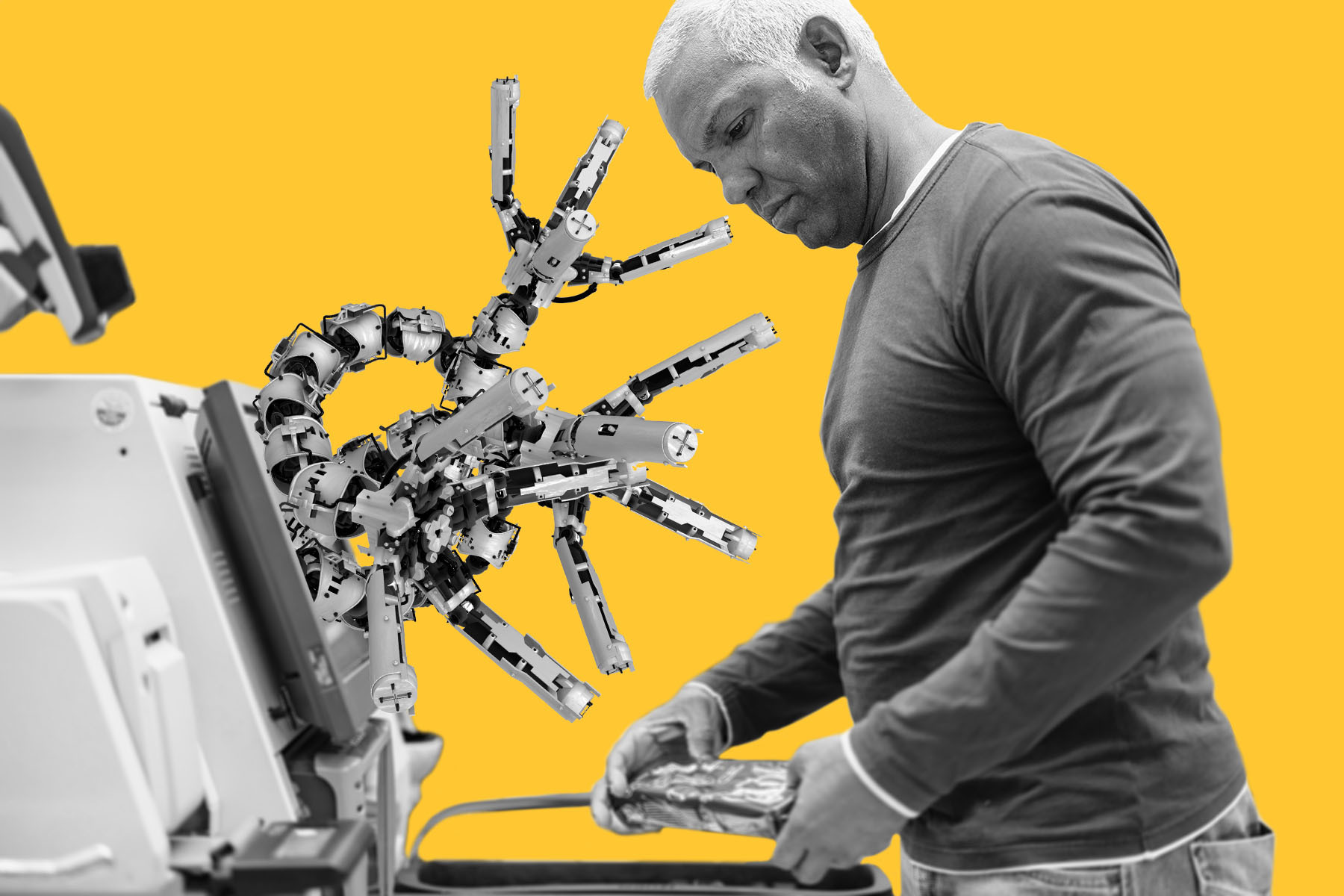If you feel like everything keeps getting worse and your quality of life is increasingly compromised by annoyances great and small, I’ll wager that started in the early 2000s, around the time retailers introduced self-checkouts on a wide scale.
The checkout has long been embedded in our retail model. You pick your goods from the shelves and visit a cashier who rings them up. You pay. You leave. With a drive to cut costs following the 2001 recession, supermarket chains began implementing self-checkout lanes in the United States and, soon after, in Canada. The technology promised a faster, more convenient experience for the shopper and, of course, labour savings for the retailer. In the process, retail giants shifted the checkout burden from employee to consumer. You still had to collect your bread, milk, and bananas and queue up. But it was now your job to also scan, pay, and bag the items while dealing with the inevitable errors and confusions that left you frantically flagging an overworked attendant to come and fix things as a dozen other people did the same.
Some days, getting out of a store with any remaining sanity is a tall order. You’re annoyed, nursing an unsettling sense that—beyond the promises of tech purveyors guaranteeing a long healthy life, a self-driving car, and a robo-butler just around the corner—the world was in a kind of death spiral. There’s a term for the steady decline of so many aspects of contemporary life, online and off: enshittification. Coined by author and journalist Cory Doctorow in 2022, it initially referred to a decline in service quality on the part of tech giants who had so thoroughly captured users that they could extract value from them without being sensitive to their preferences or needs. Social media platforms, for example, hoover up your personal data and, in return, fill your timeline with bots and trolls. Or rideshare services gouge you because it’s busy hour and you’ve hit surge pricing, but you have few other options because the apps crushed the taxi industry and public transit sucks.
Enshittification thus gets into everything, creating what Doctorow has christened the enshittocene. It’s a broad expansion of the capture–exploitation–decline cycle that can explain our analogue existence more and more as consumers become increasingly bound by limited choice, high prices, and poor experiences in oligopolistic markets.
In many ways, self-checkout is the shining jewel of enshittification. First, the technology can be deeply exasperating. According to one survey published in 2021, 67 percent of American customers said they’d experienced a failure at the self-checkout lane. Nor is it true that people whiz through: lines get clogged while staff assist with bar codes that aren’t working or payment problems. But the concept has also inspired some remarkable dystopian creativity. Amazon bragged about the Just Walk Out technology used in their Fresh grocery stores which sent customers their receipts after they had left the store with their items. However, the model was reportedly powered by low-paid workers in India who watched customers from afar and reviewed about 70 percent of purchases. (Amazon has denied these allegations.)
The behemoth is now transitioning to Dash Carts, a kind of self-checkout on the fly, allowing customers to scan their items as they shop. Sounds alluringly efficient. But apparently, it’s anything but. Tech news site GeekWire found the shopping carts equipped with cameras and sensors “clunky, inconsistent, and difficult to navigate.” The big chains can package an assault on labour as convenience because they have so little competition. If the handful of big-box grocers decide to use self-checkout, where else will you go?
The hypertrophied scope and scale of enshittification also means that retailers—confident of their market share and of their freedom to make user experience as awful as they please in order to boost revenue—bear the brunt of it too. Self-checkouts appear to have caused a surge in “shrink,” or inventory loss. The technology accounts for a shrink rate of 3.5 percent of sales in the US—which is sixteen times higher than with cashiers, who can prevent theft and are less likely than customers to make scanning errors. US retailers reported over $100 billion (US) in losses in 2022, blaming them in part on self-checkouts. In 2023, Toronto Police Service claimed retail theft to the tune of $5 billion, while shoplifting rates were up 31 percent in 2022.
Retailers have built a surveillance apparatus around self-checkouts to deter shoplifters and to detect “errors” as shoppers scan their items, often incorrectly. In the US, big-box store Target is adopting TruScan technology across its nearly 2,000 locations to watch customers and detect any unexpected items in (or not in) the bagging area (while limiting its express self-checkout lanes to those with ten items or less). In Canada, Walmart customers are monitored via video, including at self-checkout. Today, not only do folks take on the labour of purchasing their items—they’re now also closely surveilled in exchange for the privilege.
Food giant Loblaw, which has a nearly 30 percent share of the Canadian grocery market, has rolled out an array of sometimes heavy-handed measures to combat what it calls “organized crime.” The beefed-up security can include wheel-locking shopping carts and looming Plexiglas barriers (creating what one user on X called a “jailhouse feel.”) In March, Loblaw also began testing receipt scanners in Ontario. The pilot required shoppers to scan a receipt’s bar code to open a metal gate to let them leave the premises. Consumers immediately hated it, as it led to confusion at the exit, with loud alarms constantly going off. One customer quoted by the CBC said that, at a time of skyrocketing grocery prices, the measures are “just kind of kicking [shoppers] while they’re down.”
Earlier this year, some Costco locations in Canada and the US adopted their own customer scanning requirements—but not on the way out of the store. As a deterrent to a rise in membership sharing as it builds out its own self-checkout, the warehouse retailer required shoppers to scan-in as they entered the store and to be checked by a camera against their membership. More surveillance.
Despite the odds being stacked against shoppers and labourers, there’s been a recent self-checkout consumer backlash, even a decline in consumer loyalty, but it’s been modest. Still, the overall frustration has led to small wins. In April, posters encouraging shoppers to steal from Loblaws on May 12 began popping up. Later, May became the “boycott Loblaws month”—a temporary protest that, for some, is set to stretch on indefinitely even as the company met with one of the boycott organizers. At that meeting, according to Yahoo Canada, Loblaw CEO Per Bank shared the company was ditching its multi-buy promotions, which forced shoppers at No Frills locations to buy multiples of an item to get a discount. In another concession, the company finally signed the voluntary federal grocery code of conduct, which is meant to formalize and govern the relationship between food retailers and their suppliers. But it looks like Loblaws is keeping self-checkout.
Not everyone is, though. Some retailers in Canada and the US, including a handful of Canadian Tire and Walmart locations, have done away with the model. Still, the tech remains widely in use. Even when a store ditches the machines, it’s likely out of concern about shrink than customer experience.
Doctorow argues for a right of exit—the opportunity for users to easily move from one platform to another to avoid being locked in. That’s a form of competition and consumer power we could apply to the retail consumer market too. But governments aren’t exactly rushing to make this happen—to break apart retail oligopolists, to induce competition, to preserve local shops and small players as an alternative. The upshot is we are citizens of the enshittocene with no clear way out.




